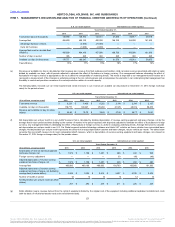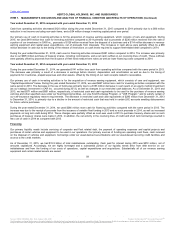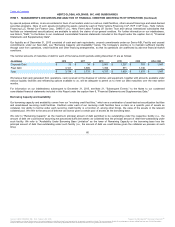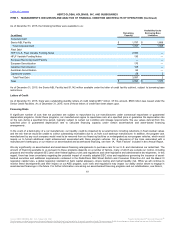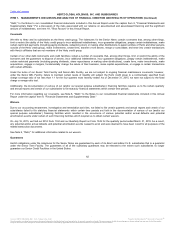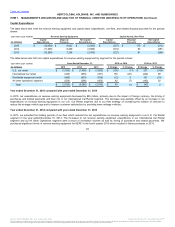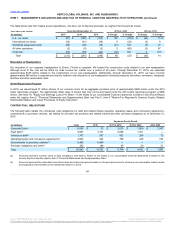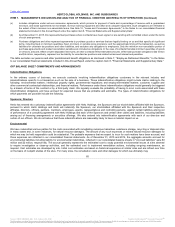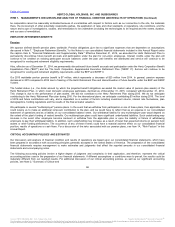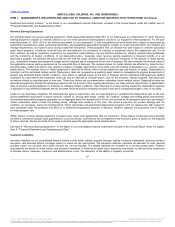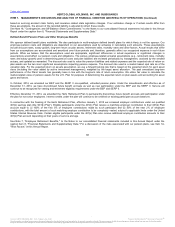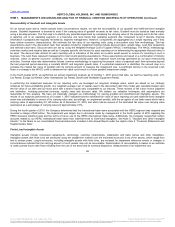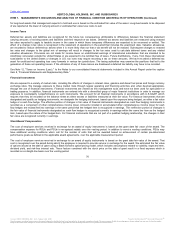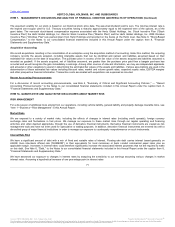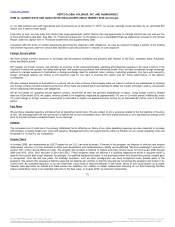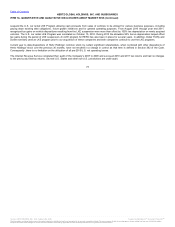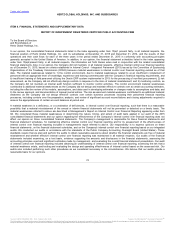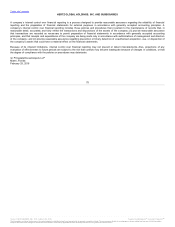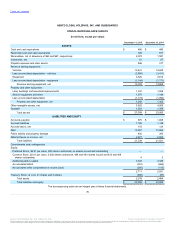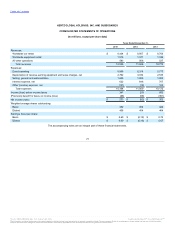Hertz 2015 Annual Report Download - page 75
Download and view the complete annual report
Please find page 75 of the 2015 Hertz annual report below. You can navigate through the pages in the report by either clicking on the pages listed below, or by using the keyword search tool below to find specific information within the annual report.
Table of Contents
Significant Accounting Policies," to the Notes to our consolidated financial statements included in this Annual Report under the caption Item 8,
"Financial Statements and Supplementary Data."
Our principal assets are revenue earning equipment, which represented approximately 56% of our total assets as of December 31, 2015. Revenue
earning equipment consists of vehicles utilized in our car rental operations and equipment utilized in our equipment rental operations. For the year
ended December 31, 2015, 42% of the vehicles purchased for our combined U.S. and International car rental fleets were subject to repurchase by
automobile manufacturers under contractual repurchase and guaranteed depreciation programs, subject to certain manufacturers' car condition and
mileage requirements, at a specific price during a specified time period. These programs limit our residual risk with respect to vehicles purchased
under these programs. Incentives received from the manufacturers for purchases of vehicles or equipment reduce the capitalized cost. For all
other vehicles, as well as equipment acquired by our equipment rental business, we use historical experience, industry residual value guidebooks
and the monitoring of market conditions, to set depreciation rates. Generally, when revenue earning equipment is acquired outside of a car
repurchase program, we estimate the period that we will hold the asset, primarily based on historical measures of the amount of rental activity
(e.g., automobile mileage and equipment usage) and the targeted age of equipment at the time of disposal. We also estimate the residual value of
the applicable revenue earning equipment at the expected time of disposal. The residual values for rental vehicles are affected by many factors,
including make, model and options, age, physical condition, mileage, sale location, time of the year and channel of disposition (e.g., auction, retail,
dealer direct). The residual value for rental equipment is affected by factors which include equipment age and amount of usage. Depreciation is
recorded over the estimated holding period. Depreciation rates are reviewed on a quarterly basis based on management's ongoing assessment of
present and estimated future market conditions, their effect on residual values at the time of disposal and the estimated holding periods. Market
conditions for used vehicle and equipment sales can also be affected by external factors such as the economy, natural disasters, fuel prices and
incentives offered by manufacturers of new cars. These key factors are considered when estimating future residual values. Depreciation rates are
adjusted prospectively through the remaining expected life. As a result of this ongoing assessment, we make periodic adjustments to depreciation
rates of revenue earning equipment in response to changing market conditions. Upon disposal of revenue earning equipment, depreciation expense
is adjusted for any difference between the net proceeds received and the remaining net book value and a corresponding gain or loss is recorded.
Under our car repurchase programs, the manufacturers agree to repurchase cars at a specified price or guarantee the depreciation rate on the cars
during established repurchase or auction periods, subject to, among other things, certain car condition, mileage and holding period requirements.
Guaranteed depreciation programs guarantee on an aggregate basis the residual value of the cars covered by the programs upon sale according to
certain parameters which include the holding period, mileage and condition of the cars. We record a provision for excess mileage and car
condition, as necessary, during the holding period. These repurchase and guaranteed depreciation programs limit our residual risk with respect to
cars purchased under the programs and allow us to determine depreciation expense in advance, however, typically the acquisition cost is higher
for these program cars.
Within Donlen, revenue earning equipment is leased under longer term agreements with our customers. These leases contain provisions whereby
we have a contracted residual value guaranteed to us by the lessee, such that we do not experience any economic gains or losses on the disposal
of these vehicles. Donlen accounts for its lease contracts using the appropriate lease classifications.
See Note 4, "Revenue Earning Equipment," to the Notes to our consolidated financial statements included in this Annual Report under the caption
Item 8, "Financial Statements and Supplementary Data."
Insurance liabilities on our consolidated balance sheets include public liability, property damage, liability insurance supplement, personal accident
insurance, and personal effects coverage claims for which we are self-insured. The insurance liabilities represent an estimate for both reported
accident claims not yet paid, and claims incurred but not yet reported. The related liabilities are recorded on a non-discounted basis. Reserve
requirements are based on rental volume and actuarial evaluations of historical accident claim experience and trends, as well as future projections
of ultimate losses, expenses, premiums and administrative costs. The adequacy of the liability is regularly monitored
67
℠
The information contained herein may not be copied, adapted or distributed and is not warranted to be accurate, complete or timely. The user assumes all risks for any damages or losses arising from any use of this information,
except to the extent such damages or losses cannot be limited or excluded by applicable law. Past financial performance is no guarantee of future results.


